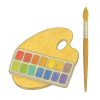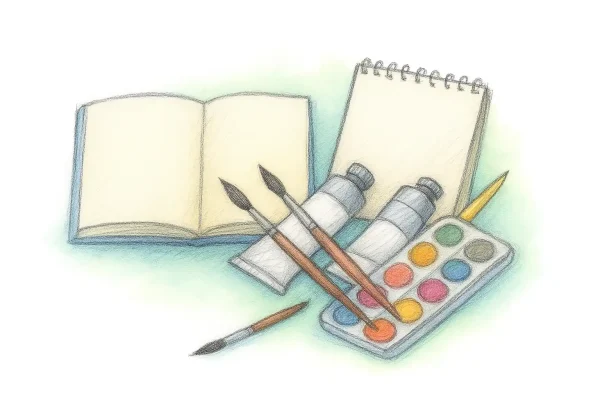Beginner’s FAQ: Watercolour Painting with Tom Ellery
1. Do I need special brushes for watercolour?
Yes — watercolour brushes are designed to hold plenty of water and release it smoothly onto the paper. Regular synthetic brushes for acrylics or oils won’t behave the same way.
For beginners, I recommend Princeton Neptune or Da Vinci Casaneo brushes — both offer great control and softness without the cost or maintenance of natural hair.
2. Can I use normal paper for watercolour painting?
Not really. Standard drawing paper will buckle and absorb pigment unevenly.
Choose proper watercolour paper — ideally 300gsm (140lb) and cold pressed. For beginners, Bockingford offers an affordable entry point, while Arches or Saunders Waterford provide professional-grade results.
3. What’s the difference between pans and tubes?
Pans are small, dry cakes of paint — portable and tidy, perfect for beginners and sketching outdoors.
Tubes contain wetter, more concentrated pigment, ideal for studio work or larger paintings.
Many artists use both: pans for convenience, tubes for mixing rich washes.
4. Do I need to stretch my paper?
If you’re using loose sheets of watercolour paper, stretching helps prevent warping when wet.
However, if you buy watercolour blocks (paper glued on all four edges), you can paint straight away — no stretching required. Bockingford and Arches both make excellent blocks.
5. How long do watercolour paints last?
A long time! Even student-grade sets like Winsor & Newton Cotman will last years if stored properly.
Tubes may dry out over time, but you can rewet and use the paint again. That’s one of the joys of watercolour — nothing goes to waste.
6. How much water should I use?
It depends on the effect you want.
- More water = lighter, more transparent washes.
- Less water = stronger, more defined colour.
Practice on scraps of paper to get a feel for different consistencies. Control comes naturally with experience.
7. Can I mix different brands of watercolour paints?
Absolutely. Professional artists often mix brands to get the best properties from each.
Just remember: artist-grade paints like Daniel Smith, Winsor & Newton Professional, and Sennelier have higher pigment loads and behave differently from student-grade paints — so always test your mixes first.
8. What’s the best way to clean my brushes?
Rinse them thoroughly in clean water after each session and reshape the tip with your fingers.
Never leave brushes standing in water — it will damage the bristles and loosen the ferrule.
For occasional deep cleaning, use a mild brush soap such as The Masters Brush Cleaner.
9. Do I need masking fluid or tape?
Masking fluid protects areas you want to keep white — like highlights or clouds — while you paint. It’s optional but useful once you’re more confident.
Daler Rowney Masking Fluid and Winsor & Newton Colourless Masking Fluid are both excellent options.
Masking tape, on the other hand, is essential for neat edges and flat paper.
10. Is watercolour suitable for complete beginners?
Definitely! While it takes time to master, it’s one of the most rewarding mediums to learn. Watercolour encourages looseness, patience, and experimentation — all valuable lessons for any artist.
Start with a few colours, a good brush, and a reliable pad of paper. From there, you’ll find your rhythm.

